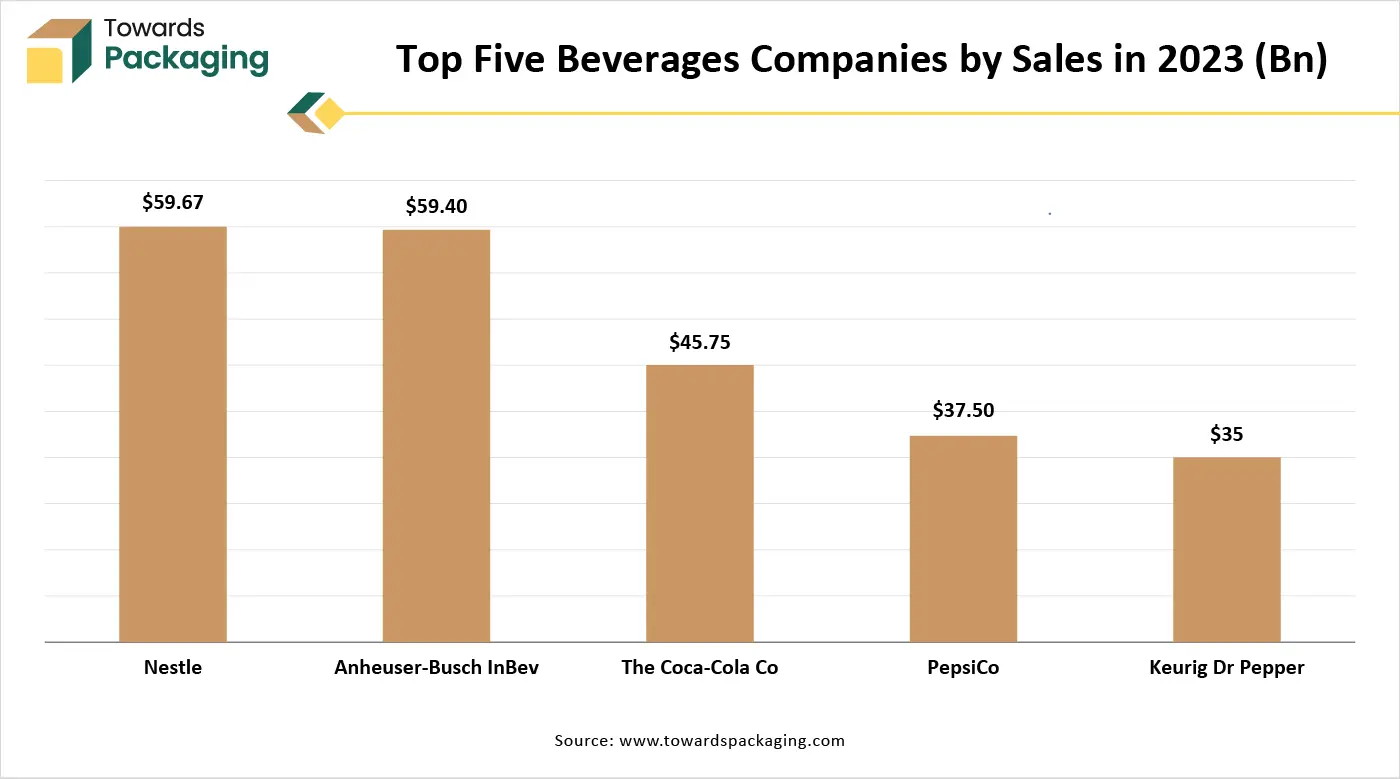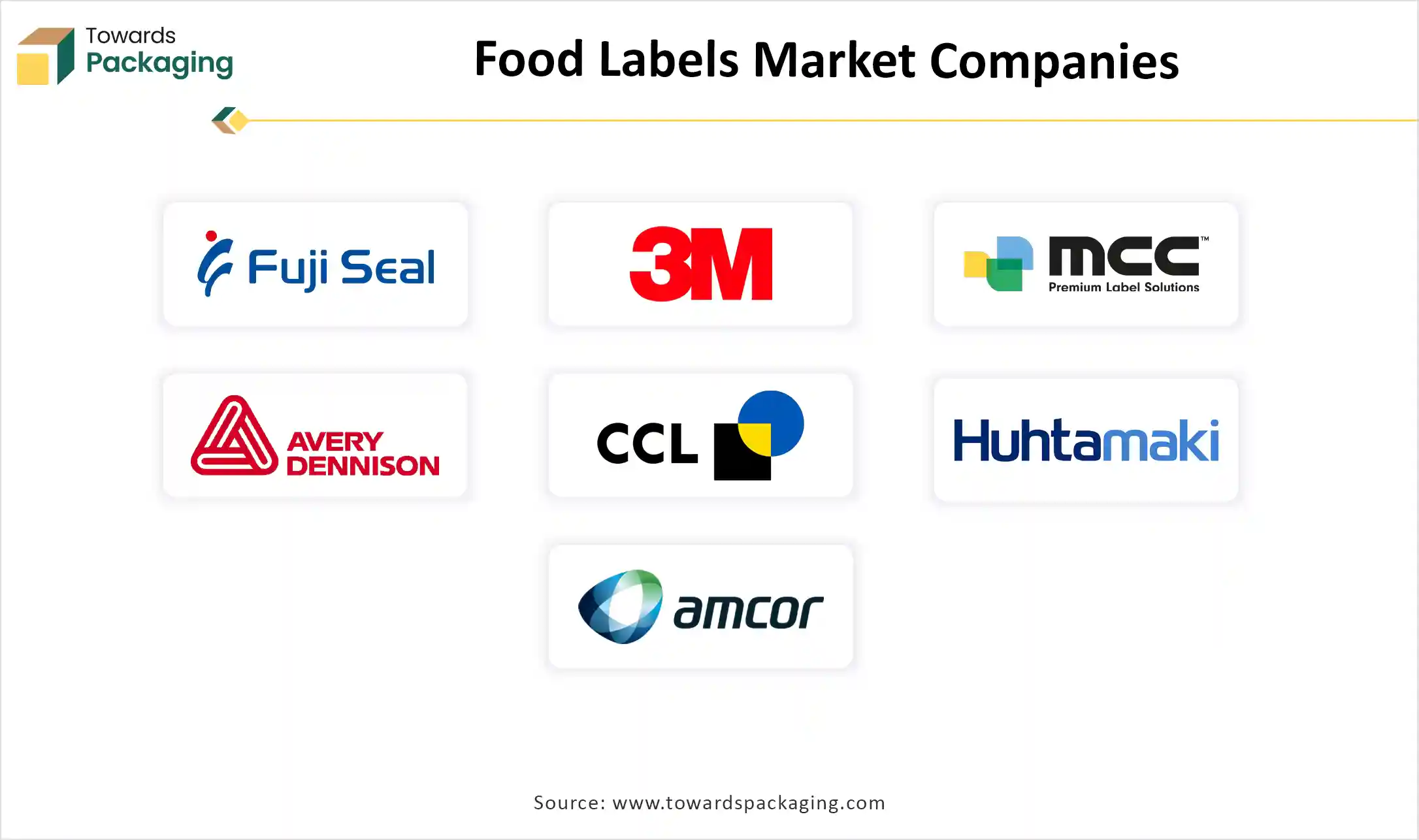April 2025
The food labels market is forecasted to expand from USD 76.74 billion in 2025 to USD 116.32 billion by 2034, growing at a CAGR of 4.73% from 2025 to 2034. This market proliferates due to the growing demand for packaged food items and technological advancements in the food labels industry. The rise of e-commerce and supermarkets is driving the growth of the market. Particularly in supermarkets, visually appealing labels are the key ingredients as they are essential in order to convey the exact brand emotion and attract consumers. All these factors are driving the growth of the food labels market and are expected to continue for the forecast period.

| Metric | Details |
| Market Size in 2024 | USD 73.27 Billion |
| Projected Market Size in 2034 | USD 116.32 Billion |
| CAGR (2025 - 2034) | 4.73% |
| Leading Region | North America |
| Market Segmentation | By Material, By Product Type, By Printing Technology, By Ink Type, By Application and By Region Covered |
| Top Key Players | Fuji Seal International, Inc., 3M Company, Multi-Color Corporation, AVERY DENNISON CORPORATION, CCL Industries, UPM Global, Toray Plastics (America), Inc. |
The increasing demand for packaged food items is driving the growth of the food labels market. The food packaging labels contain information such as the product, brand name, quantity, product ingredients, nutrition values, any food-related warnings, manufacturing date, and expiry date, etc. All of this is very crucial information for the consumers and as per the government compliances. Product branding is also very important in the current times. What kind of colour schema, design, and material quality is used in the food label that defines the positioning of the product in the market. That’s why the labels are so important for the product, as they decide the whole personification of the brand and product.
Technological advancements are shifting the market towards smart labels, which incorporate advanced technologies like the embedding of QR codes, RFID, and NFC tags, etc which help the consumer to have an interactive experience with the product where with the help of a smartphone device, they can scan the QR code and get information about product ingredients, allergic warnings, product origin and product sustainability impact such as co2 emissions etc. all these scenarios are going to increase the food label market growth in the upcoming times.
In the food labels market, the ingredient information and any allergy-related warnings must be mentioned properly, as per the regulatory authorities' compliance. if there are any discrepancies in the labeling and information, the company might have the call back the whole batch of products. Such unavoidable consequences might be there. This situation is being avoided now by the integration of AI in the food label production plants, the computer vision technology, OCR (Optical Character Recognition) technology scans the printed text, and if there is any issue, it will notify the production operators. Industrial automation is helping in the production plants to enhance production capability and reduce labor costs.
Worldwide increasing demand for packaged food items is driving the growth of the food labels market. As per the government compliances, it is mandatory to print all the ingredients and nutritional data with accuracy on the label as per the compliances. Because of this, the labels play a very crucial role in the food packaging. Increased consumption of food and beverages in packaged form is driving the growth from mineral water to alcoholic and nonalcoholic drinks. The packaged beverage market is booming very rapidly and is expected to continue the growth.

The moment of sustainable materials is also impacting the food labels market. On a global level, the many governments and organizations UN are proactively working on sustainable growth in every sector. Many governments have set targets for reductions in carbon emissions. To achieve these goals government is imposing regulations on non-eco-friendly materials and promoting the use of eco-friendly materials. Due to this food labeling market is also forced to shift towards sustainable material adoption like paper, recyclable and biodegradable plastics, etc.
Plastic in the food labels market is the dominating material due to its features like durability, lightweight, high strength, and cost-effectiveness. The printing quality of plastic labels is very premium and high quality, with vibrant colors and high-definition image quality. High durability and strength of plastic make labels that are water resistant and cannot get damaged during transport or product handling. Biodegradable plastic is also in very high demand for food labels. Paper food labels are also acquiring the market very quickly due to their biodegradability and being a very sustainable and eco-friendly food labeling material
Pressure-sensitive labels is the dominating segment for the food labels market due to their easy and convenient application on the product with no requirement for heating or anything else. They are very cost-effective also due to their mass production. Plastic and paper are both materials that can be used for the pressure-sensitive labels or also known as self-adhesive labels. Shrink labels are fastest fastest-growing label type due to their ability to fit around any food packaging container effectively. Normally, heat shrinkable materials are used in these labels, like polyester or PVC. Due to its 360-degree space coverage, it is the popular choice for the food and beverages.
Flexographic printing is dominating the printing technology segment due to its cost-effectiveness, high-quality printing, and mass production of labels, making it the most popular choice of technology for food label printing for a long time. The new technology is the fastest-growing technology, which is digital printing technology. Digital printing technology offers the ability to print customized and personalized labels with the desired amount. This personalization and customization feature is making digital printing very popular. Some premium brands use this for personalized branding, where personalized labels are printed for exclusive products and customers.
UV-based ink is dominating the food labels market due to its fast-drying process and high durability with a wide range of uses, while providing the benefits of high resistance against heat and chemicals. stringent government rules on sustainability, food safety, and regulatory compliance, environmental safety, enhanced printing quality, and cost effectiveness are making the water-based ink a popular choice for food label printing and the fastest growing ink type.
Increased demand for alcoholic and nonalcoholic beverages such as fruit juices, carbonated drinks, energy drinks, sports drinks, health drinks, milk-based drinks, and many more is driving the growth of the beverage segment in the food labels market. Consumer inclination towards packaged food beverages and the technological advancements in the food preservation industry have resulted in this. Parallelly, the bakery and confectionery is also showing significant growth in the food label market.
In 2024, North America led the food labels market. North America region with a massive packaged food industry, from chocolates to snacks, from beverages to bakery, this region is the highest consumer of packaged food items. This is resulting in the dominance of the food labels market in the North America region. Companies in this region are continuously investing in technological advancements and new innovative solutions. Emphasis on sustainable materials is the paramount thing in the North American region due to stringent government regulations and the high demand for eco-friendly products for end consumers due to increased awareness among consumers regarding environmental concerns.
Asia Pacific is seen to grow at the fastest rate during the forecast period in the food labels market. A huge population, rapidly growing urbanization, rising e-commerce, and consumers having disposable income are driving the demand for packaged food items and the growth of the food labels market in the Asia Pacific region. Continuous innovation in technology and sustainable solutions is the focal point in the Asia Pacific region food label market. Use of reusable plastics, recyclable and biodegradable plastics, and paper is highly preferred in the region due to government regulations and high demand from end consumers for sustainability.
The food labels market is expected to show notable growth in the European market due to its high demand for packaged food items in the urban population, and inclination towards new and innovative technological advancements. Sustainable materials are highly preferred in the European region due to high demand from end consumers and government pressure on the manufacturers.
Latin America, the Middle East, and African regions are contributing to the growth of the food labels market while focusing on sustainability and new technological innovation. Consumption of packaged food items in this region is growing rapidly, and this is driving the growth of the food label market in this region.

By Material
By Product Type
By Printing Technology
By Ink Type
By Application
By Region Covered
April 2025
April 2025
April 2025
April 2025